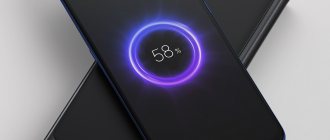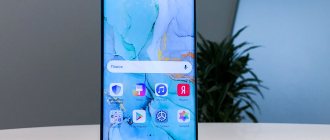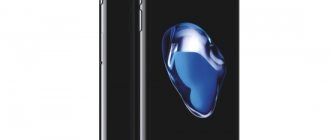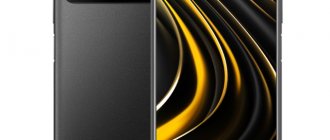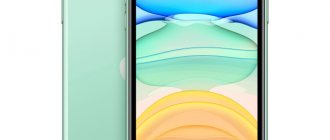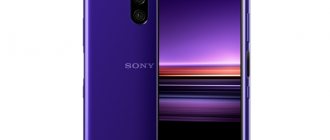Insufficient autonomy is one of the main problems of modern smartphones. To solve this problem, manufacturers can install capacious batteries or energy-efficient but low-power hardware. The second option will not suit all buyers, but increasing the battery size is a good solution. But in this case, the charging speed of the smartphone decreases, turning into 3-4 hours of waiting at the outlet. However, this drawback has long been resolved, and the user only needs to choose a good smartphone with fast charging so that the mobile device can live on the battery for a long time and quickly fill it up.
Xiaomi Mi 11
- Built-in 4600 mAh battery, 55 W fast charging, QC 4+, PD 3.0.
- Wireless charging – fast 50 W + reverse 10 W.
- Screen 6.81″, AMOLED, 3200×1440, 515 ppi, 20:9, 30-120 Hz, AOD.
- 5G processor Qualcomm SM8350 Snapdragon 888, 5nm.
- CPU – 8 cores Kryo 680 (Prime 1×2.84 GHz + Gold 3×2.42 GHz + Silver 4×1.80 GHz).
- GPU – Qualcomm Adreno 660, 840 MHz.
- Android 11 (Q) OS, MIUI 12 / 12.5 interface.
- RAM 8 GB (LPDDR5), ROM 128 / 256 GB (UFS 3.1).
- Double slot, only for 2 nanoSIM.
- Main triple AI camera 108 MP (f/1.85, PDAF, OIS).
- Additional sensors 13 MP (f/2.4, 123°) + 5 MP (f/2.4, AF=3-10 cm).
- Video recording – up to 4320p/30fps, slow-mo 240fps.
- Front AI camera 20 MP (f/2.2).
- USB Type-C 2.0, USB OTG.
- Conversational + 2 music speakers, 2 microphones.
- Wi-Fi 802.11 a/b/g/n/ac/ax, Bluetooth 5.2, 5G and 4G LTE.
- NFC (with Google Pay support), 360° light sensor, IR port.
- In-screen fingerprint + face unlock.
- On both sides there is Corning Gorilla Glass (front – Victus, back – 5).
- 4 colors, side frame - aluminum.
- H×W×D – 164.3×74.6×8.06 mm; weight – 196 g.
Next in the TOP is the fresh flagship Xiaomi Mi 11 with support for two types of turbo charging – wired 55 W and wireless 50 W. The built-in 4600 mAh battery is fully charged in 45 minutes from a wired charger or in 53 minutes when charging wirelessly. To fill the battery by more than 40%, just connect the gadget to the power supply for just 5 minutes. In half an hour the device gains more than 80% charge. There is support for Quick Charge 4+ and Power Delivery 3.0 standards. 10W reverse wireless charging is also supported.
In addition to high-speed and varied charging, the features of this smart phone include the top 5nm 5G processor Snapdragon 888 with a clock frequency of up to 2.84 GHz, Harman Kardon stereo speakers, an adaptive curved AMOLED screen of chic quality 6.81 inches diagonal with WQHD+ resolution, frequency updates up to 120 Hz and a sampling rate up to 480 Hz, as well as support for NFC and Bluetooth 5.2 technologies, a large amount of memory of the latest fast standards and a good triple camera with support for shooting 8K video and a 108 MP main sensor with optical stabilization. On the front side, the gadget is protected by high-strength Gorilla Glass Victus glass, which is more shock-resistant than previous generations and can withstand a fall from a height of 2 m.
Smartphones with the fastest charging
The smartphone can be charged for an hour or 20 minutes
Smartphone charging speed from 0 to 100% in minutes:
- Xiaomi Mi 10 Ultra – 21 minutes;
- Realme X50 Pro – 33 minutes;
- Oppo Find X2 Pro – 43 minutes;
- Xiaomi Mi 10 Pro – 46 minutes;
- Huawei Mate 40 Pro – 49 minutes;
- Realme X3 Superzoom – 56 minutes;
- OnePlus Nord – 57 minutes;
- OnePlus 8 Pro – 60 minutes;
- OnePlus 8 – 63 minutes;
- Poco X3 NFC – 63 minutes;
- Galaxy S20 Ultra – 64 minutes;
- Poco F2 Pro – 64 minutes;
- Galaxy Note 20 – 70 minutes;
- Galaxy S20 Exynos – 71 minutes;
- Huawei P40 Pro – 74 minutes.
How to quickly charge your smartphone to 100%
Xiaomi Mi 10 Ultra is officially the fastest charging smartphone on the market
The absolute leader of the rating is Xiaomi Mi 10 Ultra. Thanks to 120-watt charging, its 4,500 mAh battery charges in just 21 minutes. This became possible due to two factors.
Which Qualcomm processor was the coolest this year?
Firstly, Xiaomi divided the smartphone's battery in two, essentially providing it with two independent batteries in terms of capacity. Thus, Xiaomi Mi 10 Ultra charges in two streams.
Secondly, Xiaomi uses so-called GaN charging to charge its flagship. This is a power supply based on gallium nitride semiconductors. They are more efficient in terms of energy transfer, losing only 7% versus 20% for standard ones, and at the same time generating less heat.
Xiaomi Mi 10T Pro
- Built-in 5000mAh battery, 33W fast charging, PD 3.0.
- Screen 6.67″, IPS LCD, 2400×1080, 395 ppi, 20:9, 30-144 Hz.
- 5G processor Qualcomm SM8250 Snapdragon 865, 7 nm.
- CPU – 8 Kryo 585 cores (Prime 1×2.84 GHz + Gold 3×2.42 GHz + Silver 4×1.80 GHz).
- GPU – Qualcomm Adreno 650, 587 MHz.
- Android 10 (Q) OS, MIUI 12 interface.
- RAM 8 GB (LPDDR5), ROM 256 GB (UFS 3.1).
- Double slot, only for 2 nanoSIM.
- Main triple AI camera 108 MP (f/1.69, PDAF, OIS).
- Additional sensors 13 MP (f/2.4, 123°) + 5 MP (f/2.4, AF=2-10 cm).
- Video recording – up to 4320p/30fps, slow-mo 120fps, 30x digital zoom.
- Front AI camera 20 MP (f/2.2, FF).
- USB Type-C 2.0, USB OTG.
- Spoken/music + 1 music speakers, 2 microphones.
- Wi-Fi 802.11 a/b/g/n/ac/ax, Bluetooth 5.1, 5G and 4G LTE, infrared.
- Multifunctional NFC (with support for Google Pay).
- Fingerprint in the power button + face unlock.
- Corning Gorilla Glass 5 on both sides.
- 3 colors, side frame - aluminum.
- H×W×D – 165.1×76.4×9.33 mm; weight – 218 g.
Another gadget with support for high-speed wired charging of 33 W, which undoubtedly deserves mention in this TOP, is the advanced flagship Xiaomi Mi 10T Pro. This model features the innovative MMT parallel charging method and proprietary Fast Charge technology. In combination with each other, they provide stable and efficient charging. Using the included 33-watt AC adapter, the built-in solid 5000 mAh battery is fully charged in exactly 1 hour. Within half an hour of recharging, the smart device gains 60% charge. There is support for Power Delivery 3.0 technology.
As befits a full-fledged flagship, this gadget has received excellent equipment. The smart device boasts a powerful 7nm 5G Snapdragon 865 processor clocked at up to 2.84 GHz, an excellent 6.67-inch diagonal adaptive IPS screen with FHD+ resolution, a refresh rate of up to 144 Hz, intelligent power consumption and MEMC technology that improves smooth playback. content with a low frame rate, as well as stereo speakers, a multifunctional NFC chip, a huge amount of memory of the latest high-speed standards, a high-quality side fingerprint sensor and an excellent main triple camera with support for shooting 8K video. Particularly worth highlighting is the main wide-angle sensor of the rear camera, which has a resolution of 108 MP and is equipped with optical stabilization and 30x digital zoom.
Why fast charging is needed
120-watt charging from Baseus can charge Xiaomi Mi 10 Ultra in 20 minutes
By the way, chargers like those from Xiaomi can be bought on Ali . Here is one of these - from Baseus . This is a well-known power adapter manufacturer that you can trust. Yes, 120-watt chargers are not cheap, but with this you can simultaneously charge three devices at once: a laptop, a smartphone and, say, a tablet, or one Xiaomi Mi 10 Ultra, if you have one.
In general, it looks incredible that Xiaomi managed to go so far in the development of fast charging. The next smartphone in the ranking after Xiaomi Mi 10 Ultra is inferior to it by almost a third. This is an incredible figure that will change the way we think about charging.
How Google can make Google Pay better
After all, if now a smartphone can charge in 20 minutes to 100% and in 5-7 - up to 50%, then there is no point in leaving it charging overnight. Therefore, there is no need to set up various battery saving mechanisms that will slow down charging in order to finish it right in the morning.
Smartphone charging 100 W
I like this approach because it allows me to avoid wasting time on things I don't love. But next year we will have an even bigger breakthrough, which will happen thanks to Qualcomm. Its new Quick Charge 5 technology will allow you to charge smartphones up to 100% in just 15 minutes thanks to power adapters with a power of over 100 W. It’s clear that this will only affect flagships, but rest assured that in a couple of years, 100-watt charging will become the norm for state employees, and top-end devices will be charged in a matter of minutes.
Why aren't many flagship devices on the list?
The fact is that, if we take the Galaxy S10 as an example, it uses Fast Adaptive Charging based on the old Quick Charge 2.0 technology with a maximum charging speed of 15 W.
The Note10 supports 25W charging, while the Note10+ supports 45W charging. The latter uses the USB-PD standard - it is a competitor to Qualcomm Quick Charge. Due to the dismal experience with the Note7, you won't be able to use any chargers in the Note10+. The Note line supports chargers of the PPS (Programming Power Supply) standard. This standard allows you to change the standard voltage and current that Power Delivery technology supports. PPS reduces energy loss and heat by slowly increasing voltage and decreasing current while charging.
In addition, Note10+, in addition to PPS charging, requires a special cable marked “E”. Samsung is more sensitive to heating during charging, and 25 W charging in the Note10 performs better than 30 W charging in the OnePlus 7T.
Power Delivery technology is popular along with QC and is used, among other things, by Apple.
Honor V30 Pro
A new camera phone from Huawei, whose main focus is on the camera. DxOMark tested the device, and in the end it turned out that it is truly one of the best in terms of photo quality. But in terms of autonomy and charging speed, the phone is also good - it comes with a 40 W charger, which gives a 70% charge in 30 minutes (advertised charging speed). In fact, the speed turned out to be even higher - 80% in 30 minutes and 100% in 50 minutes.
Together with Honor V30 Pro you get a TOP 40 MP camera, powerful 7 nm Kirin 990 hardware, reverse and wireless charging. By the way, it took 2nd place in our ranking of smartphones with wireless charging. Despite its advantages, the smartphone is inexpensive - it costs 35-36 thousand rubles, and for this money it has no competitors.
⛔Cons:
- No water protection
- No stereo speakers
- It's difficult to install the Google Play Store, but there are ways
- IPS screen, most prefer OLED
If the disadvantages don’t bother you, feel free to take the Honor V30 Pro – a gorgeous phone with very fast charging, and most importantly – at an affordable price. Follow the link - review of Honor View 30 Pro
Meizu Super mCharge standard
1 Meizu Note 9 is a beautiful and multifunctional gadget
OS: Android 9.0 | Weight: 170g | Diagonal: 6.2″ | Resolution: 2244×1080 | Cameras: 48 MP, 5 MP | Processor: Qualcomm Snapdragon 675 | Memory: 64 GB | RAM: 4 GB | Battery: 4000 mAh | Connector: USB Type-C | Fast charging: yes, Meizu Super mCharge | All characteristics
| Screen | |
| Camera | |
| Autonomy | |
| Memory | |
| Performance | |
| Overall rating | 5 |
Artorias Book:
I highly recommend purchasing the phone, I bought it for 10,700 in China from
Read reviews
Video The phone is decorated with fashionable highlights, the design corresponds to today's trends. The back cover with a glossy finish is equipped with a dual camera, and a laconic company logo is indicated at the bottom. Large 6.2-inch frameless screen with a drop for front-facing and a barely noticeable chin. At the back there is a fingerprint scanner, which has already become familiar to many phone owners. The kit includes a paperclip that can be used to remove the dual SIM card tray. The appearance makes you want to buy a stylish smartphone. The characteristics did not disappoint, despite the low cost. Uninterrupted operation is ensured by a powerful 8-core Qualcomm Snapdragon 675 processor and 4GB of RAM. With this hardware, you can download games and perform everyday tasks in applications, without the gadget slowing down. A 48MP+5MP dual rear camera with autofocus and macro mode is suitable for those who like clear shots. The Full HD 2244×1080 resolution and IPS matrix provide bright and detailed images, making it convenient to watch videos with this display. The headphone jack is universal, the charger is 2A in modern USB-C format. The phone supports fast charging - after an hour the screen is 100% again. The 4000 mAh battery can hold a charge all day with active use.
Pros:
contrast shots
powerful processor
holds a charge for a long time
Minuses:
no memory card slot
the plastic surface of the lid quickly loses its original appearance without a cover
Quiet speaker, headphones don't help the situation
Huawei P30 Pro
A cheaper flagship, which in 2018 was sold for 70 thousand rubles. Now you will take it for 45-50 thousand. For the money, this is an excellent option – one of the best camera phones in the segment.
The phone is equipped with a 4200 mAh battery and comes with a 40 W charger – with it the phone gets 70% in the first 30 minutes; 90% within 45 minutes, 100% within 60 minutes. Impressive! But keep in mind: the battery heats up during the process, and this has a bad effect on its service life.
✅Other advantages:
- Cool OLED screen with HDR
- Powerful Kirin 980 processor
- High autonomy
- Cool 40 MP camera + periscope telephoto camera, providing 5x zoom without loss of quality. At one time the phone was in the TOP of DxOMark
- NFC, wireless and reverse charging
- Water protection IP68
⛔Cons:
- No stereo speakers
- No autofocus on the front camera
- No 3.5 mm jack and radio
See our Huawei P30 Pro review
OnePlus 3T - best user reviews
OnePlus is another Chinese brand that produces some of the best priced and quality phones on the market. But, unlike Xiaomi, this company does not offer such a large number of smartphones, but releases 1-2 devices per year to compete with the main flagships. The company's current smartphones today are the 5 and 5T models. But if you ask fans of the brand which phone is better to buy among the OnePlus devices available for sale, then most likely they will give preference to the older 3T.
This mobile phone boasts a wonderful display (Full HD), made using AMOLED technology, a recognizable appearance, a good main camera with a resolution of 16 MP, f/2.0 aperture and optical stabilization, as well as NFC and very powerful “filling” even by modern standards. In reviews of the smartphone, users highlight the USB-C port, delivery with a protective film glued to the screen, as many as 6 GB RAM and a good 3400 mAh battery as advantages.
Advantages:
- The device has an excellent design and reliability
- convenient system, powerful “filling” and excellent optimization
- The screen and sound in the device are very decent
- high quality GPS reception
- high quality materials and workmanship
- The smartphone charges up to 100% in an hour and a half, which is a very good result
- productive chipset
- both cameras are simply amazing for their price
- The smartphone has NFC and comes with a protective film
Flaws:
- legacy USB 2.0
- There are minor bugs in the firmware
Samsung Galaxy S7 - stylish and productive
If you need fast charging in your smartphone and a good camera at a reasonable price, then we recommend paying attention to the Galaxy S7 model from a brand from South Korea. This mobile device still remains relevant, although some of its characteristics are still outdated. For example, it still uses the old Micro USB port, and the screen has an aspect ratio of 16:9 instead of the modern elongated format.
However, this does not in the least prevent the smartphone from remaining popular among consumers. Smartphone fast charging technology allows you to quickly replenish energy if necessary, and wireless charging will be useful for those who do not want to connect and disconnect the plug every time. The hardware platform of the smartphone is simply magnificent and copes well with all applications. The camera, whose aperture is f/1.7 and resolution is 12 MP, also leaves a positive impression. By the way, it can record video in 4K resolution and is equipped with optical stabilization.
Advantages:
- Stylish appearance and high build quality
- excellent Super AMOLED matrix with high ppi
- The main camera is still ahead of many competitors
- ergonomics of the system and device are excellent
- everything works quickly, regardless of the running application
- Always On Display function, which hardly drains the battery
- availability of wireless charging function
Flaws:
- noticeable heating during fast charging
- the scanner works quickly, but not always right away
